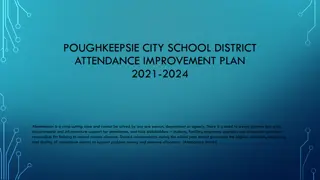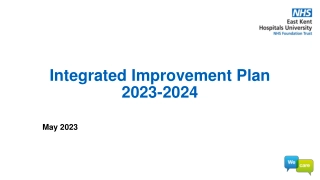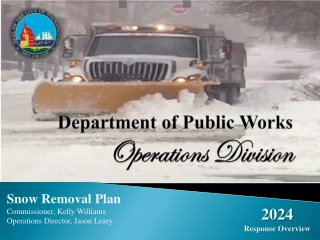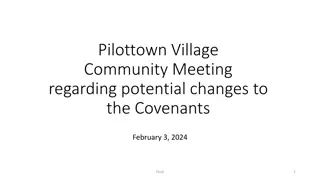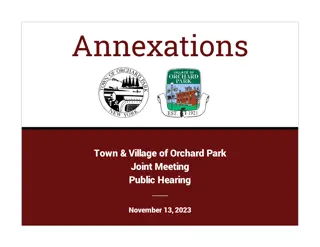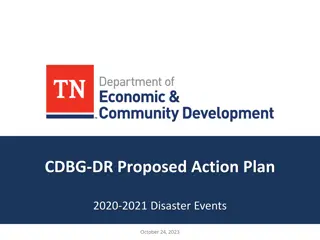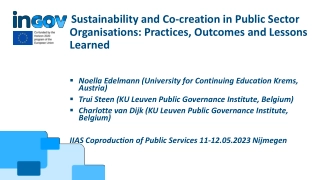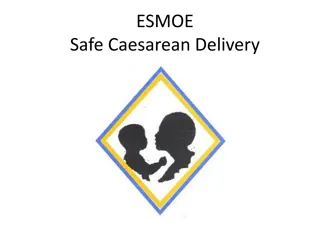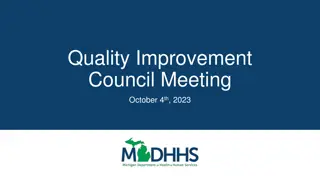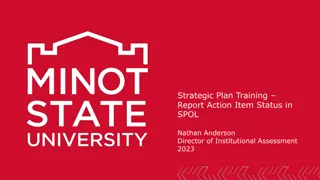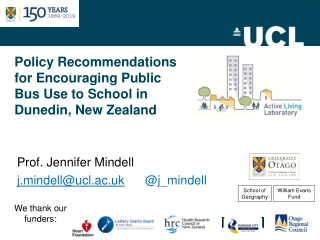Integrated Safe School Plan (ISSP) Public Meeting Overview
This overview provides detailed information on the purpose of the Integrated Safe School Plan (ISSP), the process for updating it, key components, opportunities for involvement, and resources available. It highlights the importance of the ISSP in providing emergency response information, non-emergency procedures, and the collaborative updating process led by the School Safety Committee. The content also outlines the specific data that needs to be annually reviewed and updated by the school to ensure the effectiveness of the ISSP.
Uploaded on Mar 23, 2024 | 0 Views
Integrated Safe School Plan (ISSP) Public Meeting Overview
PowerPoint presentation about 'Integrated Safe School Plan (ISSP) Public Meeting Overview'. This presentation describes the topic on This overview provides detailed information on the purpose of the Integrated Safe School Plan (ISSP), the process for updating it, key components, opportunities for involvement, and resources available. It highlights the importance of the ISSP in providing emergency response information, non-emergency procedures, and the collaborative updating process led by the School Safety Committee. The content also outlines the specific data that needs to be annually reviewed and updated by the school to ensure the effectiveness of the ISSP.. Download this presentation absolutely free.
Presentation Transcript
Integrated Safe School Plan (ISSP) Public Meeting School Name September/October date, 2023 Add school logo
Agenda I. Purpose of ISSP II. Process for Updating ISSP III. Key ISSP Components IV. Accessing the Print ISSP V. Opportunities for Involvement VI. Resources VII.Questions VIII.School s ISSP Contact
Purpose of ISSP Provides school s emergency response information, such as: Emergency team composition and locations Emergency bin location Emergency water treatment date Training/public meeting information School maps Includes non-emergency District procedures in the areas of: Campus security Plant inspections Violence prevention/intergroup relations Behavior/discipline Facilities School arrival/departure Attendance Required by Ed Code (32280-32288)
Process for Updating the ISSP Consists of a collaborative process led by the School Safety Committee (includes law enforcement representation) Requires data-gathering and analysis by the school Relies on District, online template with related policy/protocol embedded, school enters/reviews data for updates and maintains current hard copy Requires yearly (by October 1) and ongoing updates throughout the year School s current ISSP is available for review
Process for Updating the ISSP ISSP requires the following data be annually reviewed/updated or completed by the school: School Safety Committee members (the group responsible for updating the ISSP) Assessments (in up to 12 areas, such as health services, staff wellness, campus safety, mandated reporting/notification, attendance/engagement, and parent/community engagement) Identifying emergency team members for 11 teams and up to five positions Meeting locations for emergency teams Goals and data summary (for attendance, school discipline, threat/hazard and emergency function) Plans for loss of utilities Offsite locations (used in situations which require evacuating from the school premises and relocating to an off-campus site) Every School Safe training dates (topics include grooming awareness, substance use awareness, and cybersecurity)
Process for Updating the ISSP 2023-24 School Safety Committee Required Team Member Position Principal Name School enters specifics for this column UTLA Representative Classified Representative Student Representative (secondary schools) Parent (of attending student) Representative LASPD/Law Enforcement Agency Charter School Principal/Designee (if applicable)
Process for Updating the ISSP 2023-24 School Safety Committee Suggested Team Member Position School completes both columns Name School enters specifics for this column
Process for Updating the ISSP Our School s ISSP Update Process: When/how the school starts the process Committee meeting schedule Data/feedback considered for updating the ISSP Assessment process school follows Key lessons/successes/challenges School adds logo, school image, etc.
Process for Updating the ISSP Examples of 2023-24 Updates included in our School s ISSP: Add Example 1 Add Example 2 Add Example 3 School adds logo, school image, etc.
Key ISSP Components Functional Annexes To account for the whereabouts and wellbeing of all students, staff members and visitors and is one of the first tasks that must be accomplished in any emergency Accounting for All Persons All Clear To notify teachers that normal school operations can resume Crisis Response Drop, Cover, and Hold On To address the social-emotional needs of students and staff To protect students and staff from flying or falling debris, and is commonly used during an earthquake or explosion Most commonly used in response to a fire, after an earthquake, or any emergency where the building and its contents are perceived to be a threat to student safety To prevent the perpetrator from entering any occupied campus areas; students are to always remain in locked classrooms or designated safe locations Evacuate Building Lockdown
Key ISSP Components Functional Annexes Sent to 911, LASPD Watch Commander, Region Operations, parents/staff through Blackboard Connect and iSTAR (District incident reporting platform) Students and staff are encouraged to quickly leave by any safe and available exit; if leaving campus, the established off-site relocation point is the preferred destination, if the route is safe When authorities have determined that it is unsafe to remain on the campus and evacuation to an off-site relocation site is required; does not apply during an active shooter incident, a tsunami, or large hazardous materials release To place and/or keep students indoors to provide a greater level of protection from airborne contaminants in outside air, inclement weather, or other hazards To reunite students with their custodial adult after a critical incident or disaster Notifications Rapid Relocation Relocation (Off-site Evacuation) Shelter In Place Student Reunification
Key ISSP Components Threat and Hazard-Specific Annexes Involves one or more individuals on school grounds who is armed with a firearm and has already killed or wounded someone with the firearm AND at least one of the following applies: continues to shoot others; actively seeks or attacks others; has access to additional victims Active Shooter/Gunfire Aircraft/Vehicle Crash Animal Disturbance An aircraft or motor vehicle crash on or near school property Implemented when a dog, coyote, mountain lion, or other wild animal threatens the safety of students and staff Involves the discharge of a biological or chemical substance in a solid, liquid, or gaseous state; common releases within or adjacent to schools include the discharge of chemicals in a school laboratory, an overturned truck of hazardous materials in proximity of the school, or an explosion at a nearby oil refinery or other chemical plant Earthquake, serious bus accident, or other emergency that occurs while students are on a school bus field trip or being transported to or from school Biochemical/ Hazardous Materials Bus Disaster
Key ISSP Components Threat and Hazard-Specific Annexes Demonstration/ Walkout Disorderly Conduct Any assemblage on or off campus by staff or students for the purpose of protest or demonstration Conduct may involve a student, staff member, or visitor exhibiting threatening or irrational behavior Generally occur without warning and may cause minor to serious ground shaking, damage to buildings, and injuries Four distinct incident types: explosion on school property, risk of explosion on school property, explosion or risk of explosion in surrounding area, and nuclear blast or explosion involving radioactive materials Initiated upon the discovery of a suspicious package on campus grounds or receipt of a threatening phone call that may present a risk of an explosion Earthquake Explosion Explosive Device Threat/Suspicious Package
Key ISSP Components Threat and Hazard-Specific Annexes Impacts a school if it occurs on campus or in an off-campus location near the school When site personnel report suspected contamination of food or beverages served for the various food programs; applies where there is evidence of tampering with food packaging, observation of suspicious individuals in proximity to food or beverage supplies, or if notified of possible food contamination by Central District staff or local agencies Involves an infectious disease outbreak or a pandemic which requires a large-scale emergency need for medical health care services Fire Food/Water Contamination Public Health Emergency Suicide Risk and Self-Injurious Behavior Concerns or incidents should be directly reported to the administrator/designee and/or the Suicide/Threat Prevention Liaison (STPL) immediately or as soon as practically possible
Key ISSP Components Threat and Hazard-Specific Annexes Applies if site personnel receive or have knowledge of a threat that may target an individual, a particular group or the entire school community A series of ocean waves that sends surges of water onto land; typically caused by large, undersea earthquakes, but may also be caused by underwater landslides or volcanic eruptions Threat to Self/Others Tsunami Utility Failure Involves a loss of water, power, or other utility on school grounds Weather Actions taken during heavy rain, flooding, hail, or high winds
Process for Updating the ISSP Common Threats/Hazards in Our School Community In the past XX years, we have experienced... Our most challenging experience was We are well prepared for After experiencing a(n) XXXX, we now have School adds logo, school image, etc.
Key ISSP Components Emergency Teams Emergency Team Triage Description Performs triage and provides medical assistance, ensures supplies are accessible, and evacuates and stages supplies Provides psychological/emotional support for students and staff Performs search and rescue operations Ensures the safety of students and adults with access and functional needs during drills and emergencies Ensures school site security and performs short-term repairs and shutoff of utilities School Site Crisis Search and Rescue Access and Functional Needs Position Security/ Utilities
Key ISSP Components Emergency Teams Emergency Team Fire Suppression/ HazMat Assembly Area Description Extinguishes small fires and evaluates chemical spills Ensures safe evacuation and accounting for all students, staff, and visitors Processes requests for student pick-up and reunites students and parents at Reunion Gate Ensures adequate equipment and supplies Provides all necessary sanitation-related support Request/Reunion Gate Supply/Equipment Hygiene
Key ISSP Components Emergency Teams Emergency Team Transportation Support Position (optional) Documentation/ Communications Position (optional) Cost/Staff Accounting Position (optional) Manager of School Emergency Response Box Description Coordinates transportation assets and plans, such as, for an off-site relocation from the school Maintains emergency log, analyzes situation, and updates Incident Commander Maintains accurate emergency time records for all site- based and itinerant employees Evacuates the School Emergency Response Box(es) during emergencies and drills and ensures that information filed in the box is up to date
Key ISSP Components Request and Reunion Gate Teams Request Gate Responsible for processing parent requests for student release during an emergency - Greeting and directing arriving parents/guardians/designees to the Request Gate - Providing reassurance and maintaining order The use of large signs showing the school status - Checking identification of those requesting to pick up students - Directing parents/guardians to the Reunion Gate - Dispatching student runners to the Assembly Area to escort students whose parents have come to claim them Reunion Gate Responsible for reuniting parents/guardians with students and keeping accurate records of students leaving the campus - Greeting parents/guardians/designees at the Reunion Gate and maintaining order - Verifying identification and authenticity of reunification forms - Confirming students recognize the authorized adults who come to claim them and requiring adult to sign student out of school - Completing Student Release Log and submitting them to the Reunion Gate Team Leader Team Role Duties
Key ISSP Components Request and Reunion Gate Teams Request Gate Reunion Gate Location Team Members School completes all other info Add Request Gate Photo Add Reunion Gate Photo
Key ISSP Components Incident Command School Incident Command System (ICS) Incident Command Team Chart
Key ISSP Components ISSP Goals School-Specific Goal Schoolwide Discipline Plan Threat/Hazard Emergency Function School completes this column
Key ISSP Components Emergency Supplies and Equipment Our school provides a minimum 72-hour supply of emergency water, food, first aid, search and rescue, sanitation and other emergency supplies and equipment. We supplement our emergency supplies by placing specific supplies in classrooms to be used during a lockdown or shelter in place. These supplies consist of sanitation supplies, snack bars, bottled water, and simple first aid supplies.
Key ISSP Components Emergency Drills Type Fire Elementary First week* of school until proficient, then once per month* at minimum, including summer school. Within the first 30 days* of student inperson classes once per semester at minimum, including summer school. Once per month* at minimum, including summer school. Oral review or drill once per semester* at minimum, including summer school. Middle First week* of school until proficient, then once per month* at minimum, including summer school. Within the first 30 days* of student inperson classes once per semester at minimum, including summer school. Once per month* at minimum, including summer school. Oral review or drill once per semester* at minimum, including summer school. Sr. High & Adult First week* of school until proficient, then once per semester* at minimum, including summer school. Within the first 30 days* of student inperson classes once per semester at minimum, including summer school. Once per month* at minimum, including summer school. Oral review or drill once per semester* at minimum, including summer school. Lockdown Earthquake (Drop/Cover /Hold On) Shelter-in- Place
Accessing the Print ISSP Parents and community members can request to view any school s ISSP. Schools have a copy of their ISSP in the Main Office. This copy must be viewed and remain in the Main Office. All who view the ISSP public copy must enter their information in the viewing log.
Opportunities for Involvement School Safety Committee membership Volunteer for the ShakeOut or other drills, such as, at request/reunion gate Assist with classroom supply kits Assist with organizing the emergency bin
Resources Classroom Emergency Quick Guide Spanish Classroom Emergency Quick Guide
Resources Parent Emergency Information lausd.org/PEI or ParentEmergencyInformation.lausd.net Parent Emergency Guide
Resources Parent Emergency Information lausd.org/PEI ParentEmergencyInformation.lausd.net
Resources Parent Emergency Guide
Schools ISSP Contact Enter school site contact information: Name Position Email address Telephone number
We appreciate your participation today.






